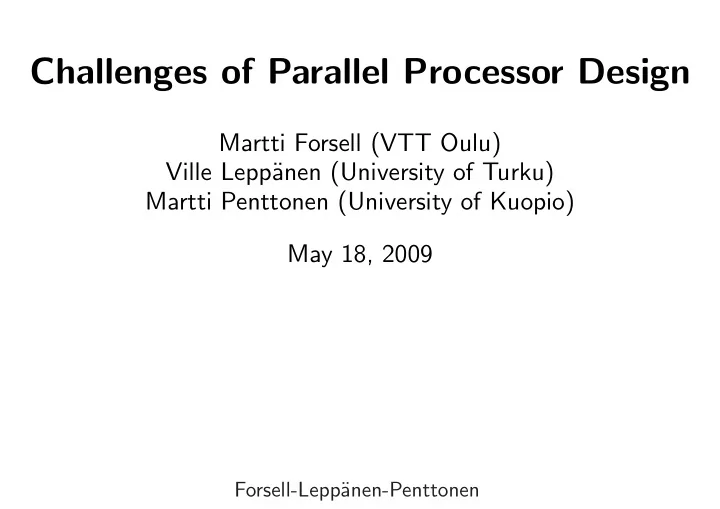

Challenges of Parallel Processor Design Martti Forsell (VTT Oulu) Ville Lepp¨ anen (University of Turku) Martti Penttonen (University of Kuopio) May 18, 2009 Forsell-Lepp¨ anen-Penttonen
Contents • Moore’s law • Latency • Slackness • PRAMs on Chip – Paraleap – Eclipse – Moving threads Forsell-Lepp¨ anen-Penttonen 1
Moore’s law • 1 component on IC in 1959 • 50 component on IC in 1965 Moore: maybe 65000 components on IC in 1975 16 years — 2 16 -fold • 2 32 (not 2 48 ) components on IC in 2007 “Packing density doubles every 18 months” • “Laws” for clock cycles, bandwidth, ... • Not until eternity! size, heat, quantum effects • What to do with all those components? Multiple cores? Forsell-Lepp¨ anen-Penttonen 2
Latency • moving data needs time • overhead of components • latency of about 100 clock cycles • want to process but must wait for data • caches - clever enough? • multiple cores - what to do with them? • threads become important Forsell-Lepp¨ anen-Penttonen 3
Slackness Does latency imply inefficiency? • What to do instead of waiting? Some other thread • Are there parallel threads? Yes, PRAM algorithmics Multiple threads per processor core: slackness • Is it technically possible to run multiple threads? Bandwidth requirements for internal network • Any number of processors • Different structure of computer • New software (at least libraries) Forsell-Lepp¨ anen-Penttonen 4
PRAM P P P memory Multiple processors running synchronously, shared memory. proc compact(A) for i=0..n-1 pardo if A[i]=0 then C[i]=0 else C[i]=1 E=prefix-sum(C) for i=0..n-1 pardo if A[i]<>0 then B[E[i]]=A[i] return B Forsell-Lepp¨ anen-Penttonen 5
PRAM continued O (1) time assuming prefix-sum in O (1) time prefix-sum(C) = (C[1],C[1]+C[2],C[1]+C[2]+C[3],...) A lot of progress in 80’ies and 90’ies. k ParTime (log k n ) Hypothesis: NC = P , where NC = � Hence, for most problems there are highly parallel algorithms. Culler et al. 1993. PRAM is not realistic. Synchronous immediate ′ ! Try DMM! access to memory is not possible. PRAM is passe ′ ? Try PRAM! Now: DMM is passe Forsell-Lepp¨ anen-Penttonen 6
Slackness • Assume program uses sp virtual processors, while computer has p real processors. We have slackness s in computation. • Assume each data fetch requires φ hops in network. In time unit pφ bandwidth need is created. • φ is not constant, therefore network must be sparse, for example sparse torus Forsell-Lepp¨ anen-Penttonen 7
PRAM on Chip What changed in fifteen years? • DMM never became very popular • Dead end in commodity processor speedup • Space on chip ⇒ PRAM on chip becomes possible PRAM on chip • Paraleap (Vishkin et al.) • our Eclipse (Forsell et al.) • our Moving threads (Lepp¨ anen et al.) Forsell-Lepp¨ anen-Penttonen 8
PRAM on Chip design challenges 1. Enough parallelism to cover latency? Yes by PRAM theory 2. Enough communication bandwidth? Use sparse network 3. Efficient management of slackness on hardware? 4. Programming not too difficult? Forsell-Lepp¨ anen-Penttonen 9
Paraleap Vishkin’s XMT (Eplicit MultiThreading) model. Not as tightly synchronous as PRAM. Forsell-Lepp¨ anen-Penttonen 10
PRAM and XMT are similar Forsell-Lepp¨ anen-Penttonen 11
PRAM and XMT are different Forsell-Lepp¨ anen-Penttonen 12
Structure of Paraleap PSU Regs P P P P MTCU ������������������� ������������������� ������������������� ������������������� ������������������� ������������������� network ������������������� ������������������� ������������������� ������������������� ������������������� ������������������� ������������������� ������������������� C C C M M M Forsell-Lepp¨ anen-Penttonen 13
How does Paraleap work? • At spawn TCU gets the number of parallel threads and TPU’s get the code for running the thread • At the beginning and whenever a thread is completed, a TPU asks the TCU for a new thread • TCU uses the prefix-sum for pointing to the next thread if any remain • When all threads have been completed, control returns to the MPU Forsell-Lepp¨ anen-Penttonen 14
Implementation issues • Prefix-sum is actually implemented sequentially. It is claimed to be fast enough. Really? How scalable? • Internal network is a mesh of trees • Implemented on FPGA (Field Programmable Gate Array) at 75 MHz • Current version has 64 TPU’s in 4 clusters of 16 TPU’s sharing some functional units and network access Forsell-Lepp¨ anen-Penttonen 15
Paraleap exists Forsell-Lepp¨ anen-Penttonen 16
Paleap goes ASIC Forsell-Lepp¨ anen-Penttonen 17
Eclipse • strong PRAM models on chip • interleaved multithreading exploits slackess of algorithms • chained sequential functional units • supports instruction level parallelism of sequential code • sparse mesh • local memories and “scratchpads” (used for multioperations) • compiler, simulated running, • FPGA implementation planned Forsell-Lepp¨ anen-Penttonen 18
Structure of Eclipse S S S S S S S S S t c t c t c M P M P M P I I I a a a Fast memory bank S S S S S S Scratchpad S S S mux t c t c t c M P M P M P ALU I I I a a a Pending Pending S S S Reply Data Op Address Address Address S S S Thread Thread S S S t c t c t c Data Data M P M P M P I I I a a a Forsell-Lepp¨ anen-Penttonen 19
Moving threads • Processors have local memory • For data access, process with environment registers moves to the processor that has the data • No two-way traffic for a read. Fewer but bigger data packets • Tentative design exists, simulations by software Forsell-Lepp¨ anen-Penttonen 20
CUDA project • use NVIDIA graphic processor as shared memory parallel computer • cheap processing power • special libraries written Forsell-Lepp¨ anen-Penttonen 21
Conclusions • PRAM on chip seems feasible • Breakthrough? • A lot of work remains to be done • For popular introduction in Karelian, see http://opastajat.net “luvekkua karjalakse” (The same appeared in Finnish in Tietojenksittelytiede) Forsell-Lepp¨ anen-Penttonen 22
Recommend
More recommend